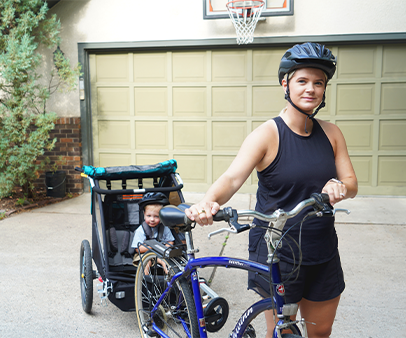Do you currently have a hernia or just had hernia surgery and are unsure of what clothes are best? While some people may not experience any pain, others may find it difficult to perform everyday tasks and pain may limit their ability to enjoy doing the things they love.
Know What Type of Hernia You Have
Before looking into various types of hernia support clothing, it is important to understand the different types of hernias. A hernia occurs when an organ or tissue pushes through a weak spot in the surrounding muscle or connective tissue. Understanding the specific type of hernia you have is essential determining the appropriate support clothing.1
- Inguinal hernias: most prevalent in males, occurring when the intestine or bladder protrudes through the abdominal wall or into the inguinal canal.
- Femoral hernias: less common and typically affect women. These hernias occur when the intestine enters the femoral canal, which is located just below the groin crease.
- Umbilical hernias: characterized by a bulge near the belly button, often occurring in infants and pregnant women.
- Incisional hernias: develops at the site of a previous surgical incision.
- Hiatal hernia: a condition where the top of your stomach bulges through an opening in your diaphragm.2
Wearing hernia support pieces can temporarily ease the physical pain, but surgery is the only way to repair a hernia.3 Your surgeon may recommend taking certain steps to improve your health as well as supportive clothing.
Hernia Belts and Trusses3
A hernia belt is a type of garment that is intended to provide support and apply compression to the hernia. The belt works by gently pressing the contents of the hernia (the intestines or other tissue that is bulging through the weak spot) back inside the abdomen.
Since hernia pain can be caused by the bulging of intestines, this compression can provide temporary relief while you are wearing the belt or truss, but the bulge and pain typically return shortly after you remove the garment.
Your doctor might recommend using a hernia belt or truss as a “bridge” to provide symptom relief until it is time for hernia repair surgery. But for a hernia belt or truss to work, it must be worn properly and should not push onto the hernia.4 Your doctor can perform tests to diagnose your hernia and recommend if, and when, you should wear a hernia belt or truss.3 Factors your doctor may consider include:
- Developing an umbilical hernia while pregnant: your doctor may recommend wearing a hernia belt during your pregnancy and until you are fully healed after delivering your baby.3
- Travel or business plans when initially diagnosed: with supervision from a doctor, the hernia belt or truss can be beneficial to help minimize symptoms and the need for immediate surgery.4
Be sure to talk with your doctor before wearing a hernia belt or truss.
Hernia Support Underwear1
Hernia support underwear can provide relief and support for individuals with hernias. It is important to choose underwear that fits snugly, but not so tightly that it causes discomfort or constriction. Hernia support underwear is designed to apply gentle pressure to the affected area, helping to keep the hernia in place and prevent it from protruding further.
Hernia-Specific Bras2
Choosing the right bra while experiencing a hiatal hernia can help prevent discomfort. Here are factors you should consider when buying a bra for a hernia:
- Choose soft cups: Wearing tight bras can restrict the lymph flow around the breast. Bras with smooth cups may offer great support and comfort.
- Drop underwire: It is recommended that women with hiatal hernias only wear soft cup bras, or bras without underwires such as a low-impact sports bra that does not have a tight band around the bottom. This will help prevent pain from the wire or tight band pressing against your chest.6
- Sizing: Ill-fitting bras that are too tight can be uncomfortable and irritating. It's best to experiment with different sizes until you can find the right fit where you feel comfortable.2 Because comfortable clothing is key, women with hiatal hernias may need to try a looser band size.6
What to Wear After Hernia Surgery7
If you recently had hernia repair surgery, certain types of clothing and fabrics may help make your recovery process more comfortable. Here are a few recommendations to help you decide what to wear:
- Loose fitting clothes: Loose fitting clothing is preferred post-hernia surgery because it prevents putting pressure on the surgical site.
- Fabric and clothing material: Wearing fabrics that are soft, breathable, and non-irritating can feel more comfortable on the surgical site. Try to avoid rough textures, tight elastics, and seams that could irritate the incision site.
- Front opening garments: Wearing front opening garments (button-up shirts, zip-up hoodies, etc.) allow for easier outfit changes without straining the stomach area of the surgical site.
- Hernia belt: Abdominal compression garments, also known as a “hernia belt,” wrap around the abdomen, fitting tightly to help provide support but not so tightly that they cut off circulation to the area.8
- Longer under garments: Longer under garments (bicycle shorts or Spanx) for hernia support may be appropriate if you have had liposuction in the legs and thighs in addition to your abdominal procedure.8
Footwear For After Hernia Surgery7
In addition to clothing and fabric recommendations, shoes are another thing to consider during your recovery process.
- Supportive shoes: supportive, comfortable shoes that provide ample cushioning and stability may help you maintain proper posture and reduce strain on the body during the healing process.
- Ease of wearing: shoes that are easy to put on/take off without bending or stretching excessively can be helpful during the early stages of recovery.
- Avoid high heels: refrain from wearing high heels during the healing process as it can alter your gait—potentially causing additional strain on the abdominal muscles and surgical site.
- Consider orthotics: if you have pre-existing foot conditions or require additional support, consult with a podiatrist about using orthotic inserts. Customized orthotics can help alleviate foot discomfort, provide more support, and aid in a smoother recovery.
Choosing the best hernia support clothing is important for your comfort, support, and overall well-being. Ask your doctor whether a hernia support garment is appropriate for you, and which type he or she recommends for your individual condition.
The guidance provided in this article follows general rules that should be discussed with your doctor. This article is for informational and educational purposes only. It does not substitute for medical advice. If in doubt, always consult your doctor.
Related Articles
Join the HerniaInfo.com community! Get notified about our latest articles and updates on all things hernia as they become available.
References
- https://esteem-compression-apparel.com/blogs/news/the-ultimate-guide-to-choosing-the-best-hernia-support-underwear-a-comprehensive-review
- https://www.cottonique.com/blogs/articles/4-factors-to-consider-when-choosing-the-right-bra-for-hiatal-hernia
- https://surgery.wustl.edu/are-hernia-belts-effective/
- https://bostonhernia.com/faq/is-it-safe-to-use-a-hernia-belt-or-hernia-truss
- https://myhealth.alberta.ca/Health/aftercareinformation/pages/conditions.aspx?hwid=uf7669
- https://pinkribboninc.com/bra-troubleshooting/
- https://www.herniainnovations.com/blog/what-to-wear-after-hernia-surgery-dressing-for-comfort-and-proper-recovery
- https://drdumanian.com/wear-hernia-surgery/
This site is not intended as a substitute for professional medical care. Only your physician can diagnose and appropriately treat your symptoms. BD does not recommend the use of any particular physician or team of physicians. Please consult your healthcare provider for advice regarding who should be part of your hernia repair team.
BD-120312


